
Have you ever wondered how to ensure everyone in your project stays informed and aligned? A communication plan is your answer. It outlines who needs to know what, when, and how, ensuring smooth operations and successful outcomes. Whether it’s for coordinating a project or keeping stakeholders updated, communication plan templates come in handy for clarity and efficiency.
These templates save you time, ensure consistency, and enhance professionalism. They guide you through the planning process, making it easier to develop clear and effective communication strategies. Ready to streamline your communication efforts? Let’s dive into the benefits and best practices of using communication plan templates.
What is a communication plan?
A communication plan is a strategic document that outlines how information will be disseminated within an organization or project. It defines the communication objectives, identifies the target audience, specifies the key messages to be conveyed, and outlines the channels and timeline for communication activities.
The primary goal of a communication plan is to ensure that all stakeholders are informed and engaged, which is crucial for the success of any project or organization. It serves as a roadmap for delivering information effectively and efficiently.
By establishing clear communication protocols, the plan helps prevent misunderstandings, aligns team members with project goals, and enhances overall coordination and productivity.
Benefits of using communication plan templates
Leveraging communication plan templates offers numerous advantages, streamlining the process of keeping stakeholders informed and engaged. Here are the key benefits:
Time-saving
Creating a communication plan from scratch can be time-consuming. Templates provide a ready-made structure that significantly reduces the time required to develop a comprehensive plan. This allows teams to focus more on tailoring the content to their specific needs rather than building the framework.
Consistency
Templates ensure that all communication plans within an organization follow a consistent format and include all necessary components. This consistency helps maintain a unified approach to communication, making it easier for team members and stakeholders to understand and follow the plan.
Clarity and organization
A well-designed template guides users through the process of creating a communication plan, ensuring that all critical elements are included. This structure helps in organizing information logically and clearly, which is essential for effective communication.
Professionalism
Using templates helps produce polished and professional-looking communication plans. This enhances the credibility of the communication efforts and ensures that all plans meet a certain standard of quality.
Flexibility
While templates provide a structured approach, they are also flexible enough to be customized to fit the specific needs of different projects or organizations. This adaptability ensures that the communication plan is relevant and effective for the particular context it is being used in.
Improved efficiency
By streamlining the process of creating communication plans, templates improve overall efficiency. Teams can quickly develop and implement communication strategies, leading to more timely and effective dissemination of information.
Enhanced coordination
Templates ensure that all necessary details are covered, facilitating better coordination among team members. This comprehensive approach helps in aligning all communication activities with the overall project or organizational goals.
Error reduction
Templates minimize the risk of omitting crucial information. By providing a checklist of required elements, they help ensure that nothing is overlooked, leading to more robust and reliable communication plans.
Types of communication plan templates
Effective communication is crucial for the success of any project or initiative. To streamline and manage communication efforts, businesses can leverage various communication plan templates. Here, we introduce six types of templates that cater to different needs and scenarios:
Project communication plan template
A project communication plan is essential for managing communication within a project. It serves as a roadmap for how information will be shared among project stakeholders, ensuring that everyone is informed and engaged.
When designing a website for a client, you need to coordinate with both the freelance web designer and the client at various project stages. If you’re setting up your own store and don’t know how to start, you’ll need to communicate with even more people, such as a lawyers, business coaches, and recruiters.
A project management communication plan helps organize these communication tasks to ensure the project’s success. Here’s how:
1. Define communication objectives
- Project alignment: Establish objectives that ensure all stakeholders are aligned with the project’s goals and timelines.
- Clarity and transparency: Ensure that the communication plan promotes clear and transparent information sharing among all parties involved.
2. Identify and analyze stakeholders
- Internal stakeholders: Include project team members, management, and other internal departments that need to be kept informed about the project’s progress.
- External stakeholders: Identify clients, partners, vendors, and any other external parties who require updates on the project’s status and key milestones.
3. Develop and prioritize key messages
- Project updates: Create consistent messages that provide updates on project milestones, progress, and any issues that arise.
- Stakeholder-specific information: Tailor messages for different stakeholder groups to address their unique concerns and interests.
4. Choose appropriate communication channels
- Internal channels: Select channels like project management software, email, and internal meetings for team communication.
- External channels: Use channels such as client meetings, status reports, and newsletters to communicate with external stakeholders.
5. Establish a communication schedule
- Regular updates: Schedule regular updates, such as weekly status reports and monthly progress reviews, to keep stakeholders informed.
- Milestone notifications: Plan communications around key project milestones to ensure timely and relevant information is shared.
6. Assign roles and responsibilities
- Communication leads: Designate team members responsible for managing communications with specific stakeholder groups.
- Task allocation: Clearly define who is responsible for creating, reviewing, and disseminating project communications.
7. Implement monitoring and feedback mechanisms
- Real-time monitoring: Use project management tools to track communication effectiveness and gather real-time feedback.
- Continuous improvement: Be prepared to adjust communication strategies based on feedback and project developments to enhance effectiveness.
8. Conduct post-project evaluation
- Review process: Conduct a thorough review of the communication plan’s effectiveness at the end of the project.
- Lessons learned: Gather insights and lessons learned from all stakeholders to improve future project communication plans.
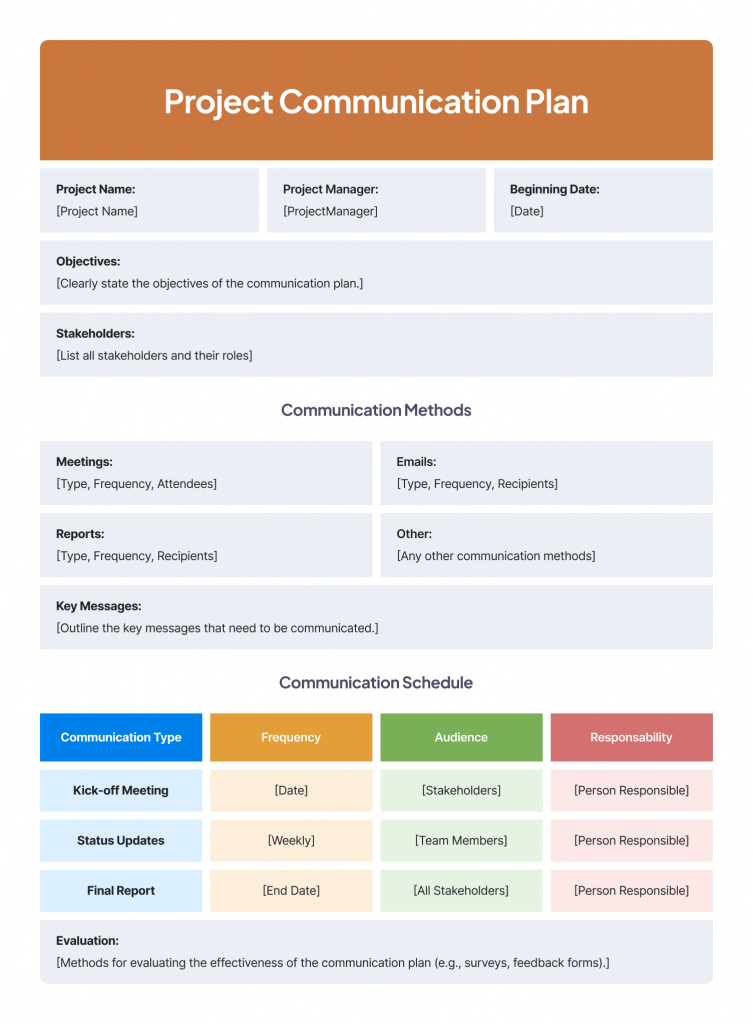
Product launch communication plan template
A product launch communication plan is crucial for effectively disseminating information about a new product. It ensures that all stakeholders are informed and engaged, contributing to a successful launch.
Your template should include fields for different product launch messages. For example, you might send a product feature kit to customers and a press release to media partners. Specify the content for each message in your template.
Include other specifics, such as whether you’ll use a custom sales email template for subscribers and the tone for each stakeholder group. Here’s a quick overview:
1. Establish clear objectives
- Specific goals: Define the primary goals of the product launch, such as increasing brand awareness, driving sales, or capturing market share.
- Success metrics: Determine measurable outcomes to evaluate the success of the launch, such as sales targets, social media engagement, and lead generation.
2. Identify key stakeholders
- Internal teams: Ensure all relevant departments, including marketing, sales, customer support, and management, are informed and aligned with the launch strategy.
- External parties: Identify and communicate with customers, partners, media, and influencers who will be involved or impacted by the product launch.
3. Develop key messages
- Core messaging: Create clear and consistent messages that highlight the product’s unique features, benefits, and value proposition.
- Segmented communication: Tailor messages for different stakeholder groups to address their specific needs and interests.
4. Select communication channels
- Diverse channels: Choose appropriate channels for communication, such as social media, email marketing, content marketing, press releases, and live events.
- Integrated strategy: Develop a strategy for each channel, ensuring they complement each other and create a cohesive campaign.
5. Schedule and coordinate
- Content calendar: Plan and schedule content in advance to ensure consistent and timely communication across all channels.
- Event coordination: Plan launch events, webinars, and other activities that will create buzz and engage stakeholders.
6. Assign roles and responsibilities
- Clear assignments: Define the roles and responsibilities of team members involved in the launch, ensuring everyone knows their tasks.
- Collaboration tools: Utilize project management and business collaboration tools to streamline communication and task management among team members.
7. Monitor and adjust
- Real-time monitoring: Use analytics tools to track the performance of your launch activities and gather real-time data.
- Flexible adjustments: Be prepared to adjust your strategy based on the data collected, making necessary changes to optimize outcomes.
8. Evaluate and learn
- Post-launch review: Conduct a thorough review after the launch to evaluate what worked well and what didn’t.
- Feedback integration: Gather feedback from all stakeholders and integrate lessons learned into future product launches to continuously improve your processes.
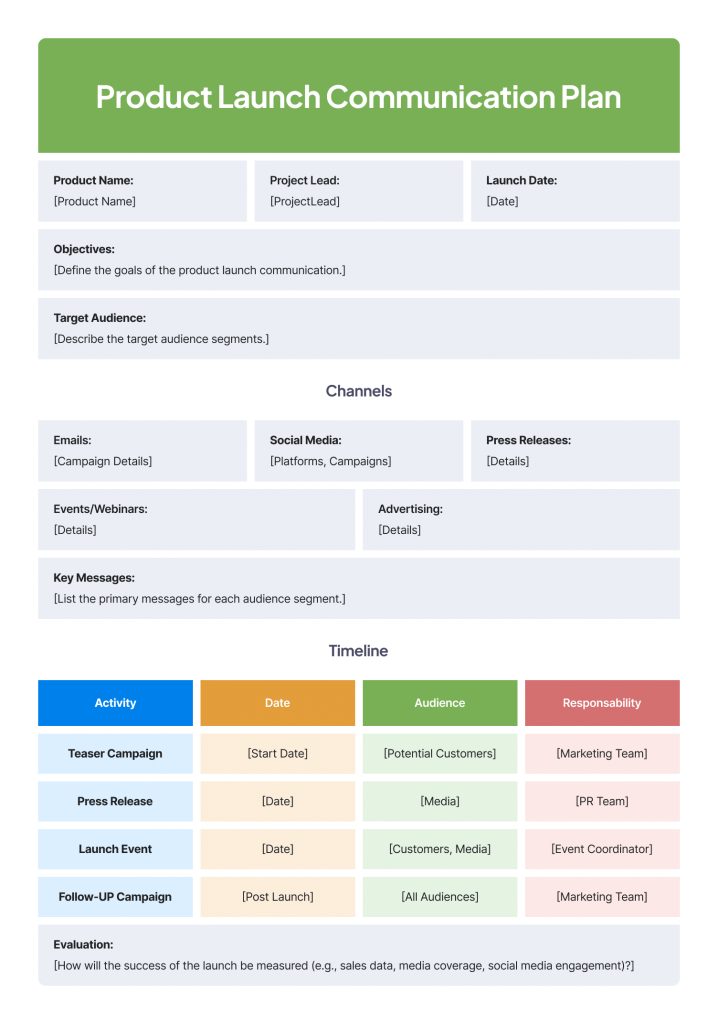
Crisis communication plan template
A crisis communication plan is essential for managing the dissemination of information during a crisis. It ensures that all stakeholders are informed and engaged, helping to mitigate the impact of the crisis. Here are key considerations for an effective crisis communication plan:
1. Establish clear objectives
- Crisis goals: Define the primary goals of the crisis communication plan, such as protecting the company’s reputation, ensuring the safety of stakeholders, and providing timely and accurate information.
- Measurable outcomes: Set measurable outcomes to evaluate the effectiveness of the communication efforts, such as stakeholder satisfaction, media coverage, and resolution time.
2. Develop key messages
- Consistent messaging: Craft clear and consistent messages that convey the nature of the crisis, the company’s response, and any actions stakeholders should take.
- Empathy and transparency: Ensure that messages express empathy, transparency, and a commitment to resolving the crisis.
3. Determine communication channels
- Multi-channel approach: Select the appropriate channels for crisis communication, such as press releases, social media, email, website updates, text messages, and direct phone calls.
- Channel strategy: Develop a strategy for each channel, considering its reach and effectiveness in delivering timely updates.
4. Create a communication timeline
- Immediate actions: Outline the immediate actions to be taken once a crisis is identified, including initial notifications and press releases.
- Ongoing updates: Schedule regular updates to keep stakeholders informed about the status of the crisis and the company’s response efforts.
5. Prepare pre-approved statements
- Crisis scenarios: Develop pre-approved statements for various potential crisis scenarios to ensure rapid response.
- Approval process: Establish a streamlined approval process for releasing statements to avoid delays in communication.
6. Monitor and respond
- Real-time monitoring: Use tools to monitor media coverage, social media mentions, and stakeholder feedback in real-time.
- Adapt and respond: Be prepared to adapt messages and strategies based on the evolving situation and stakeholder responses.
7. Post-crisis evaluation
- Debriefing: Conduct a debriefing session with the crisis management team to review the response and identify lessons learned.
- Performance metrics: Analyze performance metrics, such as response times, media coverage, and stakeholder feedback, to assess the effectiveness of the communication plan.
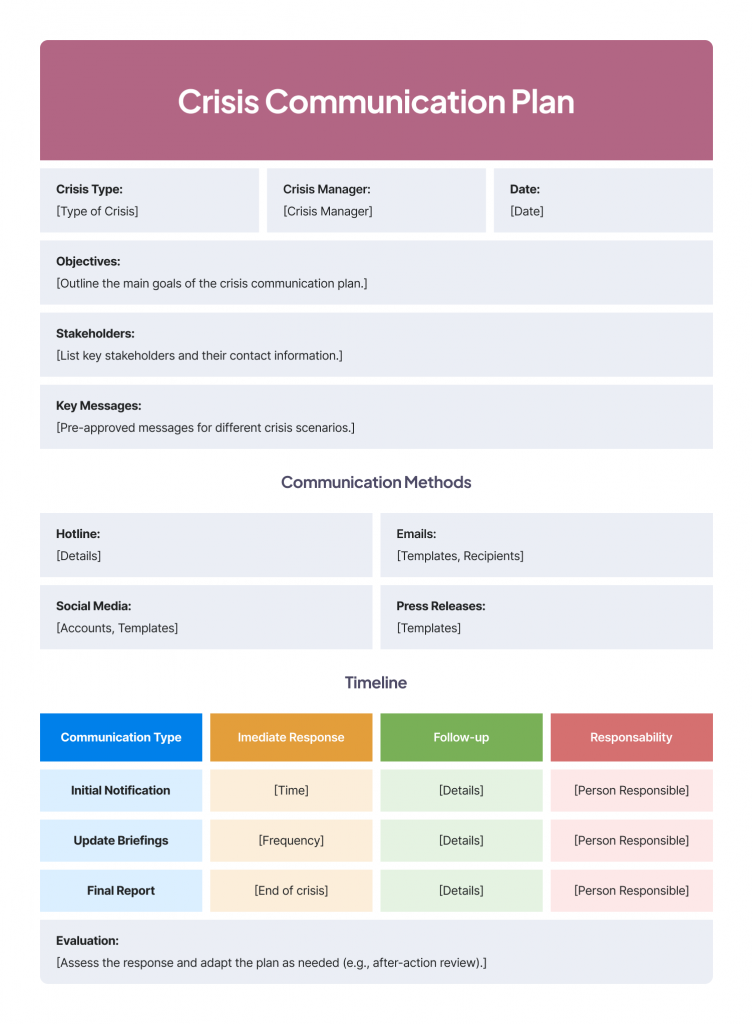
Marketing communication plan template
A marketing communication plan is essential for managing the dissemination of information about a marketing campaign. It ensures that all stakeholders are informed and engaged, contributing to a successful campaign.
Your marketing plan should also outline how to communicate with media partners, especially if you’re hosting events that you want to be covered. Here’s what you should keep in mind:
1. Define your objectives
- Specific goals: Clearly outline what you aim to achieve with your marketing campaign, such as increasing brand awareness, generating leads, or boosting sales.
- Measurable outcomes: Set measurable outcomes to track the success of your campaign, such as key performance indicators (KPIs) like click-through rates, conversion rates, and engagement metrics.
2. Identify your target audience
- Audience segmentation: Segment your audience based on demographics, behaviors, and preferences to tailor your messages effectively.
- Persona development: Create detailed buyer personas to understand your audience’s needs, challenges, and motivations.
3. Develop key messages
- Consistent messaging: Craft clear and consistent messages that align with your brand values and campaign objectives.
- Value proposition: Highlight the unique value proposition of your product or service and how it addresses the needs of your target audience.
4. Choose the right channels
- Multi-channel approach: Select the appropriate channels for your campaign, such as social media, email marketing, content marketing, paid advertising, and public relations.
- Channel strategy: Develop a strategy for each channel, considering its strengths and how it fits into your overall campaign.
5. Create a content calendar
- Scheduled content: Plan and schedule your content in advance to ensure consistent and timely communication.
- Content types: Diversify your content types, including blog posts, videos, infographics, social media posts, and newsletters.
6. Assign responsibilities
- Role clarity: Clearly define the roles and responsibilities of team members involved in the campaign.
- Collaboration tools: Utilize project management and collaboration tools to streamline communication and task management.
7. Monitor and evaluate
- Performance tracking: Regularly monitor the performance of your campaign using analytics tools to track KPIs and metrics.
- Feedback and improvement: Collect feedback from stakeholders and analyze the data to identify areas for improvement and optimize future campaigns.
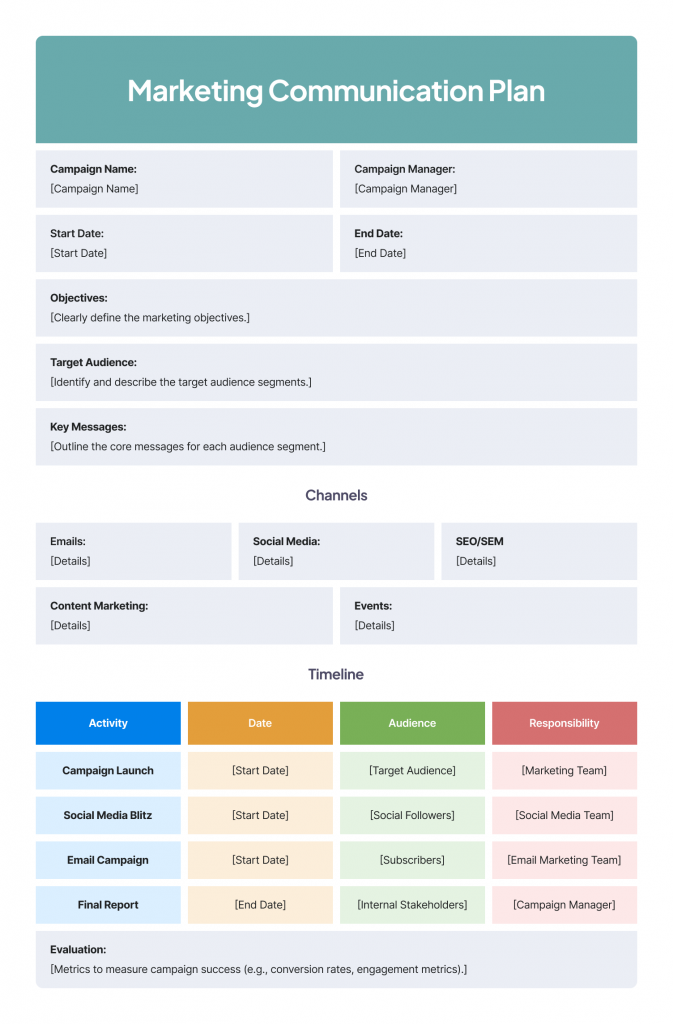
Internal communication plan template
An internal communication plan is essential for managing the flow of information within an organization. It ensures that all employees are informed, engaged, and aligned with the company’s goals. It also helps convey new onboarding strategies or workplace arrangements (e.g., remote and on-site work split).
For onboarding, the template should specify tools for new hires, platforms for sharing corporate values and policies, and key messages. For new workplace arrangements, it should detail team collaboration tools. Read along to see how an internal communication plan template ensures your team stays informed and aligned.
1. Clear objectives and consistent messaging
- Goal setting: Establishes specific communication goals tailored to the organization’s needs, such as improving employee engagement, ensuring consistent messaging, and aligning all departments with the company’s objectives.
- Unified communication: Maintains a unified voice across all channels, ensuring that employees receive consistent and clear information.
2. Targeted employee engagement
- Enhanced communication: Identifies different employee groups and their specific communication needs, ensuring tailored messages for all levels of the organization.
- Active involvement: Communication plan templates keep employees informed about company goals, changes, and updates, encouraging their active involvement and promptly addressing their concerns.
3. Efficient information flow and role clarity
- Defined channels and schedules: Clearly outlines communication methods and schedules, such as regular newsletters, team meetings, and intranet updates, ensuring timely delivery of information.
- Assigned responsibilities: Clarifies the roles and responsibilities of team members involved in internal communication, enhancing coordination and efficiency.
4. Improved operational efficiency
- Structured approach: Provides a structured approach to internal communication, ensuring all activities are well-coordinated and aligned with business goals.
- Timely updates: Facilitates real-time updates and adjustments, helping manage any issues or changes smoothly within the organization.
5. Monitoring and evaluation
- Performance metrics: Includes methods for evaluating the effectiveness of internal communications, such as tracking open rates for emails, participation in meetings, and employee feedback.
- Continuous improvement: Allows businesses to analyze the data collected, learn from the results, and make necessary improvements in the communication strategy, ensuring ongoing effectiveness and responsiveness to employee needs.
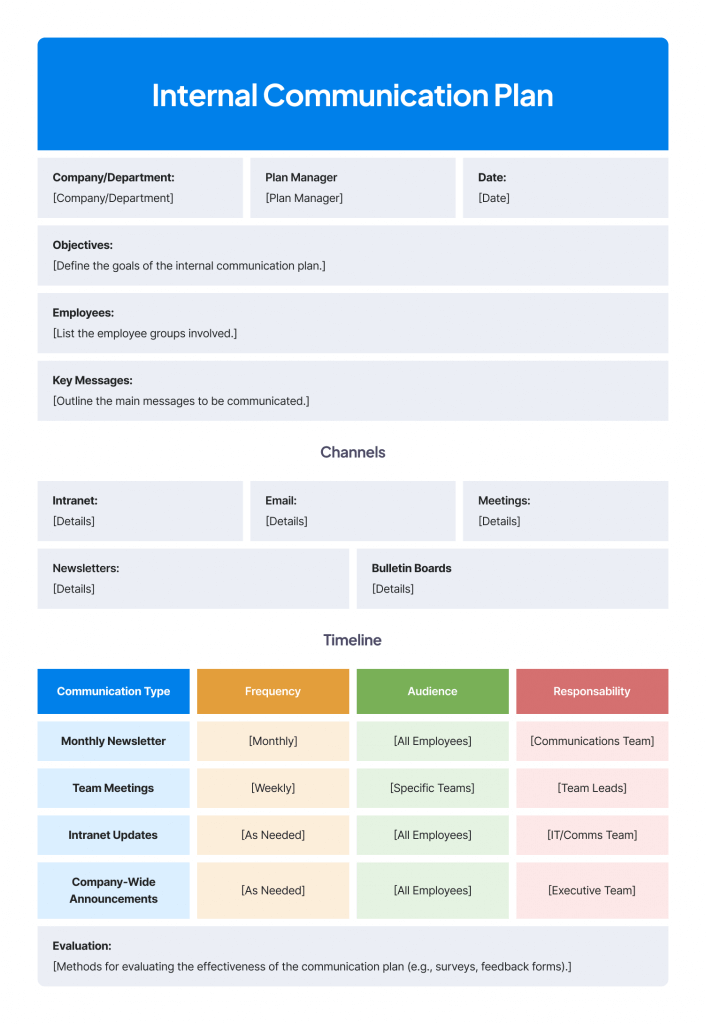
Event communication plan template
An event communication plan is essential for managing the flow of information before, during, and after an event. It ensures that all stakeholders are informed, engaged, and aligned with the event’s goals. Here’s how it helps:
1. Clear objectives and consistent messaging
- Goal setting: The template helps businesses clearly define the objectives of the event, such as increasing brand awareness, engaging attendees, or launching a new product.
- Unified communication: Ensures that all messages communicated before, during, and after the event are consistent and aligned with the event’s goals, maintaining a unified brand voice across all channels.
2. Stakeholder engagement
- Tailored messages: Helps identify different stakeholder groups (e.g., attendees, sponsors, partners) and tailor messages to meet their specific needs and interests.
- Active involvement: Keeps all stakeholders informed about event details, updates, and changes, encouraging active participation and addressing any concerns promptly.
3. Efficient information flow and role clarity
- Defined channels and schedules: Outlines the communication methods and schedules, such as email campaigns, social media updates, and press releases, ensuring timely delivery of information.
- Assigned responsibilities: Clarifies the roles and responsibilities of team members involved in event communication, enhancing coordination and efficiency.
4. Enhanced event coordination
- Detailed planning: Provides a structured approach to planning all communication activities, from pre-event promotions to post-event follow-ups, ensuring nothing is overlooked.
- Real-time updates: Facilitates real-time updates and adjustments, helping manage any issues or changes smoothly during the event.
5. Monitoring and evaluation
- Performance metrics: Includes methods for tracking the effectiveness of communication efforts, such as engagement rates, attendance numbers, and feedback from participants.
- Continuous improvement: Communication plan templates allow businesses to analyze the data collected, learn from the results, and make necessary improvements for future events.
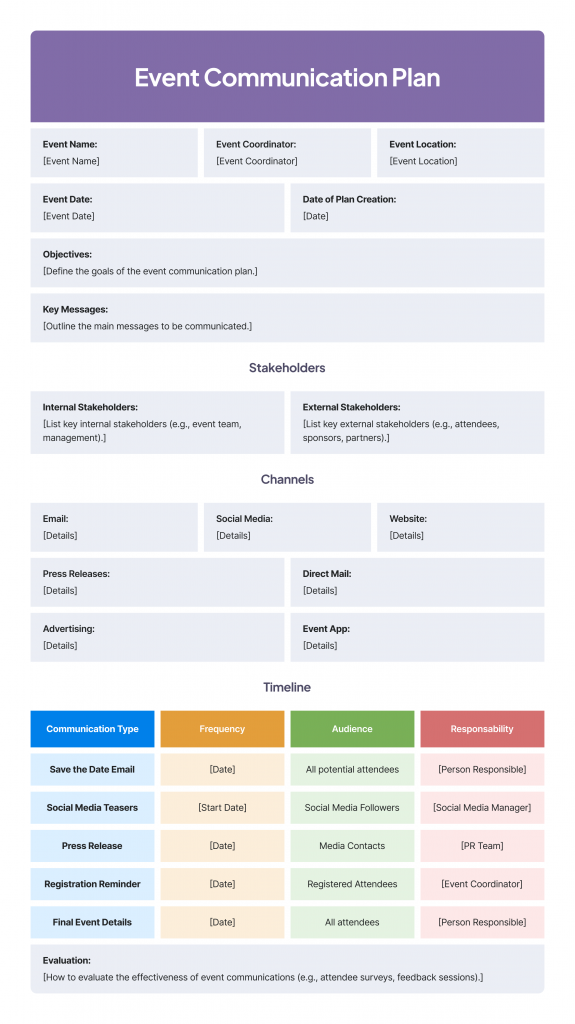
Conclusion
Effective communication is important for the success of any business initiative. Utilizing communication plan templates streamlines the process, ensuring that the right information is shared with the right stakeholders promptly. These templates save time and effort, providing a structured format that can be easily customized for various needs.
By adopting communication plan templates, you ensure consistency, clarity, and efficiency in your communications. Whether you’re managing a project, launching a product, or navigating a crisis, these templates help you maintain a coherent communication strategy.
Frequently Asked Questions (FAQs)
A strategic communications plan outlines your goals, audience, messaging, channels, timeline, and metrics. It’s a roadmap for delivering consistent, effective communication aligned with business objectives.
Effectiveness can be measured by setting clear objectives and key performance indicators (KPIs), such as audience engagement rates, message retention, behavior change, and achievement of communication goals. Regular evaluation and feedback help in refining the strategy.
Strategic communication ensures that all messaging aligns with the organization’s goals, builds trust with stakeholders, and supports consistent, clear decision-making, both internally and externally.
Textmagic helps turn your communication plan into action with tools for scheduling, segmentation, automation, and performance tracking. Once your messaging strategy is mapped out, you can use Textmagic to execute each step: send timely messages, reach the right audiences, automate key follow-ups, and monitor results in real time.
Yes. Textmagic includes built-in reporting and analytics so you can monitor message delivery, open rates, response times, and overall engagement. This helps you evaluate what’s working, adjust your messaging strategy, and make data-driven decisions for both internal updates and client outreach.
Related articles
How to craft a customer acquisition strategy that drives results
Acquiring new customers can be challenging for busin...
What is value-based selling and how it outperforms traditional sales strategies?
Traditional selling feels like a one-way street, whe...
The ultimate A2P 10DLC guide: What you need to know to get started
Over the last few years, registering 10-digit long c...
How to measure and improve your SMS conversion rates
With rising customer acquisition costs and today’s u...
20 Business email examples to elevate your professional communication
Discover effective business email examples, template...




